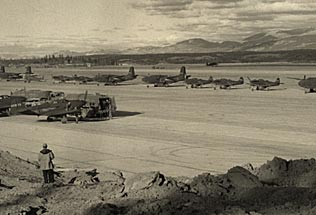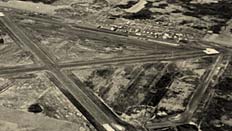The route in wartime
When the United States entered the war in late 1941 Canada offered the use of the Northwest Staging Route "for the duration". Under a lend-lease agreement with Canada, the U.S. used the route to ferry its bombers to the U.S.S.R. and to ship material to the developing front in the Aleutian Islands. This became the only shipping route to supply both the war in Europe and the fronts in Asia.
This is a rare view of Douglas A-20 "Boston" or "Havoc" bombers and Bell P-39 fighters....Thousands of American-made combat planes were thus ferried to the U.S.S.R. (view more details)

The Northwest Staging Route also had a role in the construction of the Alaska Highway. The route chosen for the highway was based, in part, on the existence of the Northwest Staging Route airports. Military expediency determined that supplies for the airports would be transported on the road, and the highway could also be used as a landmark to aid flyers on their way to Alaska. The airports were further upgraded by the U.S. Army, and eight intermediate air fields were built at Dawson Creek, Beatton River, Blueberry, Sikhanni Chief, Smith River, Teslin, Aishihik and Snag.
In 1943 the Canadian government became worried about sovereignty issues in the northwest and the potential post war use of these airports by the United States. There was speculation that the investment of American money in the route was for future civilian commercial purposes. To retain control of the route, Canada paid for all construction and improvements - a total of $58,000,000.
An aerial shot of Fort St. John runways (view more details)


